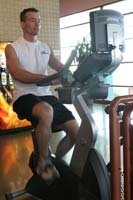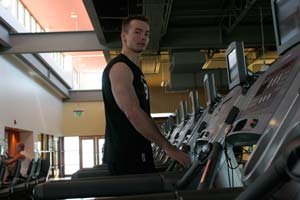
Stubborn Muscle Hypertrophy Workouts
 Table Of Contents:
Table Of Contents:
- Chapter 1 - Introduction
- Chapter 2 - What is Skeletal Muscle Hypertrophy?
- Chapter 3 - Specialized Chest Hypertrophy Workout
- Chapter 4 - Specialized Back Hypertrophy Workout
- Chapter 5 - Specialized Arm Hypertrophy Workout
- Chapter 6 - Specialized Leg Hypertrophy Workout
- Chapter 7 - Specialized Delt & Trap Hypertrophy Workout
- Chapter 8 - Specialized Calf Hypertrophy Workout
- Chapter 9 - Ab Training during a Stubborn Muscle Hypertrophy Routine
- Chapter 10 - Cardio during a Stubborn Muscle Hypertrophy Routine
- Chapter 11 - Nutrition for a Stubborn Muscle Hypertrophy Program
- Chapter 12 - Workout Nutrition/Supplementation
- Chapter 13 - Conclusion

Chapter 9
Ab Training During A Stubborn Muscle Hypertrophy Routine
I usually do not list an abdominal training routine in my programs. The reason for this is mainly because people tend to do their own things when it comes to ab training. In addition, if you are squatting and deadlifting heavy along with doing the other exercises in this program your abs are going to get worked HARD! If you wish to do direct ab training though, I recommend training abs two times a week as follows.

 Ab Workout #1:
Ab Workout #1:
- Decline Crunches 3 X 8-12
- Back Extensions 3 X 8-12
 Click Here For A Printable Log Of Ab Workout 1.
Click Here For A Printable Log Of Ab Workout 1.

 Ab Workout #2:
Ab Workout #2:
- Lying or Hanging Leg Raises 3 X 8-12
- Torso Twist 3 X 8-12
 Click Here For A Printable Log Of Ab Workout #2.
Click Here For A Printable Log Of Ab Workout #2.
With these exercises you are hitting your entire core: abs, obliques, and lower back. I recommend doing 8-12 reps for abs, which means you are most likely going to have to hold some weights and do weighted ab exercises. Some people believe that doing weighted ab exercises will lead to big, blocky, extended abs. I do not agree with this belief at all.

Chapter 10
Cardio During A Stubborn Muscle Hypertrophy Routine
Endurance (A.K.A. cardiovascular training) improves the heart's ability to pump blood and increases oxygen uptake into cells. A "fit" person also burns more fat at rest and during exercise than an unfit person.
Bodybuilders use cardiovascular training mainly as a means to increase caloric expenditure thereby increasing fat loss or decreasing fat gain. This chapter will address one cardio strategy bodybuilders can do while trying to gain lean mass or during any developmental stage based on both scientific literature and anecdotal feedback.

 Low-Moderate Intensity Cardio On Weight Training Days:
Low-Moderate Intensity Cardio On Weight Training Days:
As stated in the intro, bodybuilders primarily use cardio as a means in increase their caloric expenditure (Cardiovascular training has a TON of other health benefits, but we will not touch on those benefits here).
The use of low-intensity cardio, done either pre or post weight training, allows one to burn more calories while not hampering recovery. In fact, low-intensity cardio done post-workout may even enhance recovery due to increase blood flow and nutrient delivery.
Low-intensity cardio is not as strenuous on the body as high-intensity cardio or high-intensity interval training (HIIT). It would be very hard for someone to complete a HIIT session pre weight training as it would decrease your performance when lifting weights or to complete the session post weight training as you will already be fatigued.
We want to keep the body healthy and injury free. If you get injured then your workouts will suffer or cease altogether. Therefore, I feel it is more practical to perform low to moderate intensity cardio on weight training days. Now one could perform their cardio separate from their weight training, but for most that would mean two trips to the gym, which is impractical; Hence my recommendation to perform cardio pre or post weight training.
Whether you choose to do your cardio pre or post weight training is a personal preference. Remember, your main goal is to hit it hard in the weight room.
If doing cardio pre weight training decreases your performance then it would be better for you to do it post workout. If you find that you are too tired to do cardio post weight training or simply find you become too bored and do not finish your cardio sessions, it would be better for you to do your cardio pre weight training.

 High-Intensity/High-Intensity-Interval Training On Non-Weight Training Days:
High-Intensity/High-Intensity-Interval Training On Non-Weight Training Days:
High-intensity cardio stresses both the aerobic and anaerobic energy systems. The anaerobic energy system is what is stressed during weight training.
Putting too much stress on the anaerobic system and hampering recovery is one reason why I do not recommend performing weight training and HIIT on the same day. Obviously running at 6 mph will burn more calories than running at 3 mph, but one has to balance their activities to allow for proper recovery.
There are two main types of high-intensity cardio:
- Continuous
- Interval Training
Continuous high-intensity cardio would be running at a high speed on the treadmill or elliptical machine for a long duration (i.e. 5+ minutes).
Interval training involves alternating periods of work and rest (or lower levels of work). For example, running a 100 meter sprint then walking back to the start, resting, then repeating could constitute HIIT. HIIT is more intense than high-intensity continuous cardio and much more intense than low-intensity cardio.
Now it is time to create a program and to put it into action.

 Weight Training And Cardio Programs:
Weight Training And Cardio Programs:
The following two programs would be ideal for someone trying to add lean mass:
- Monday: 45-60 minutes Weight Training followed by 20-30 minutes Low-Intensity Cardio
- Tuesday: 45-60 minutes Weight Training followed by 20-30 minutes Low-Intensity Cardio
- Wednesday: OFF
- Thursday: 45-60 minutes Weight Training followed by 20-30 minutes Low-Intensity Cardio
- Friday: 45-60 minutes Weight Training followed by 20-30 minutes Low-Intensity Cardio
- Saturday: OFF
- Sunday: Some much needed REST!
***Note: As you lose weight and your fitness level improves you will most likely have to increase you duration and intensity of your cardio sessions.
OR
- Monday: 45-60 minutes Weight Training
- Tuesday: 45-60 minutes Weight Training
- Wednesday: 15-30 minutes of High-Intensity Cardio on the Elliptical Machine
- Thursday: 45-60 minutes Weight Training
- Friday: 45-60 minutes Weight Training
- Saturday: HIIT—Sprints: Ten 100 meter sprints
- Sunday: Some much needed REST!
***Note: As you lose weight and your fitness level improves you will most likely have to increase you duration and intensity of your cardio sessions.
As bodybuilders, weight training is your primary concern. You do not want to do too much cardio and impair your recovery from weight training. Whether trying to gain muscle or lose fat cardio should be done. The exact amount will vary by your goal, fitness level, and ability to recover.



